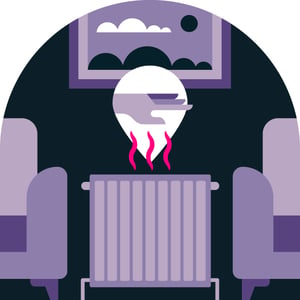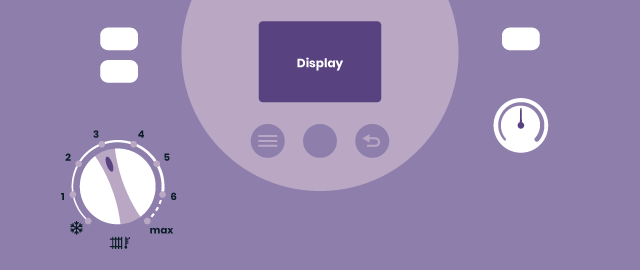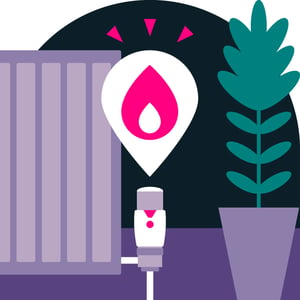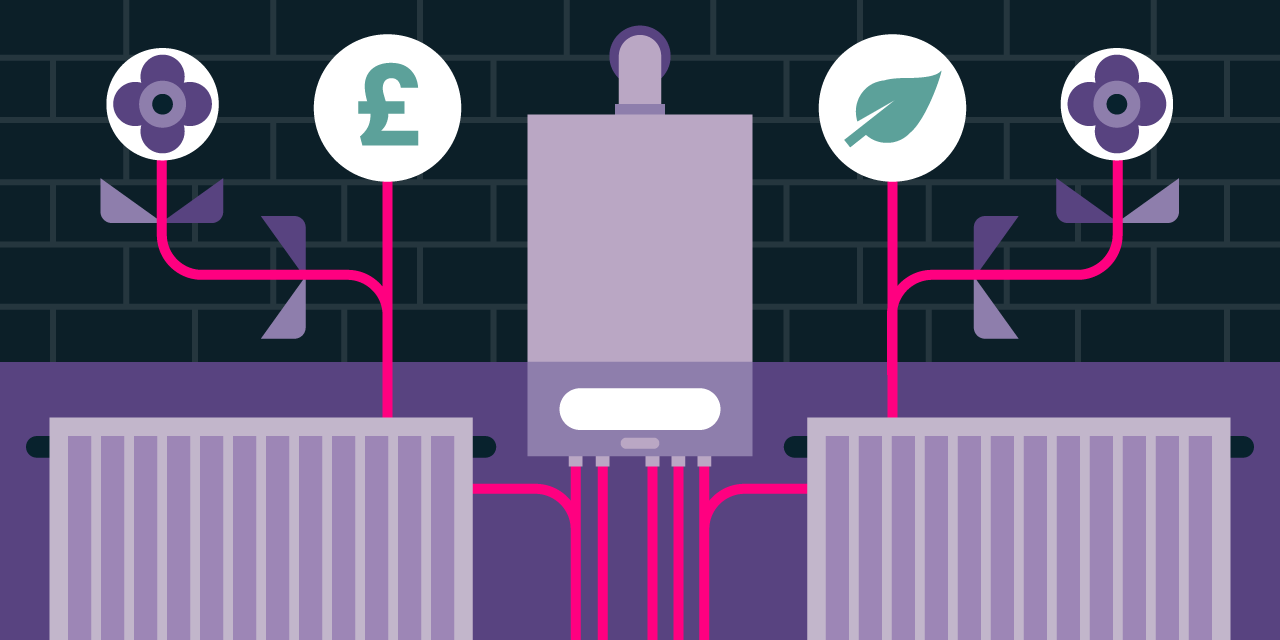How to save money by changing one boiler setting
Most people could cut their energy use by 6-8% by making a quick tweak to their boiler settings. And all without changing the temperature in their rooms.
That’s because the majority of boilers in the UK aren’t running as efficiently as they should be. Millions of people are burning more gas, creating more emissions, and spending more money on home heating than they need to.
Most boilers are designed to send water to your radiators at temperatures under 60°C, but they’re often not configured this way. This ‘flow temperature’ is usually set between 60°C and 80°C instead, which is much too high for boilers to operate efficiently.
That’s why taking 10 minutes to lower the flow temperature on your boiler could help you reduce your energy use and bills.
We’ve got a guide on how to do this below, using only the controls on your boiler’s front panel. There’s no risk of breaking your heating system, so why not try it today?
If you’d like more information on why lowering boiler flow temperatures is important for increasing efficiency and reducing energy use, watch The Heating Hub’s video on reducing flow temperatures.
Why wasn't my boiler installed with efficient settings?
There are a few reasons why boilers are usually set up with higher flow temperatures. Firstly, a large skills and knowledge gap in the industry simply means many installers haven’t been properly trained on installing modern, high-efficiency boilers. To make matters worse, boiler manuals often suggest using higher flow temperatures.
However, even engineers that do have the knowledge can be reluctant to do so to avoid complaints, call backs and bad reviews. That’s because households, who expect radiators to be scorching hot, would think their boiler isn’t working properly if they had cooler radiators caused by lower flow temperatures.
Similarly, some very poorly insulated homes may not be as suitable for lower flow temperatures. Even though this is a small number of homes, engineers may feel safer setting up boilers in a uniform, but inefficient way, to guarantee the set up will provide enough warmth and comfort regardless of property type. This is also why boiler manuals may suggest using high flow temperatures.
Won’t my house be colder?
Lowering your boiler’s flow temperature isn’t about changing the temperature on the thermostat. Your home’s temperature won’t change at all. You’ll simply allow your boiler to heat your home in a way that saves energy and money.

You’re also likely to feel more comfortable with a consistent, ambient warmth, as the water running through your radiators won’t be as hot. There’ll also be less risk of your radiators burning you or others in your household.
How do I change my boiler settings?
Some research we did with Nesta earlier this year was the precursor to their current Money Saving Boiler Challenge. Visit the site for step-by-step instructions on how to change your boiler settings. The Heating Hub also have a video about lowering boiler flow temperatures, with the instructions starting at 3:30. There are also instructions below, if you prefer.
Instructions
- First, you’ll need to make sure your heating system is suitable. You’ll need to have a gas boiler without a hot water tank. If you have a hot water tank in your home you won’t be able to make these changes.
- Locate your boiler controls. These will be on the front of your boiler and may be hidden behind a flap.
- Take a picture of your boiler controls and settings, in case you ever want to return to your original settings.
- Identify which of the following control layouts your boiler has in steps 5a, 5b, 5c, and follow the respective instructions.
5a. My boiler only has buttons

-
-
- Find the radiator symbol and press the button it relates to. The display will then change to show what the current flow temperature is set to.

- You can now use the buttons that signify an increase or decrease in value to change the flow temperature to 60°C.
- Press the ‘OK’ button, or the radiator button again (if you don’t have an ‘OK’ button), to confirm your selection.
- Find the radiator symbol and press the button it relates to. The display will then change to show what the current flow temperature is set to.
-
5b. My boiler has multiple dials

-
-
- Find the dial with a radiator symbol next to it.
-

-
-
- Turn this dial to roughly match those in the diagram below.
-

-
-
- If your boiler has a digital display, it will show you your new flow temperature. You should continue tweaking your dial until it shows 60°C. Once the change is confirmed, the display may show a different temperature. Don't worry, it'll likely be the current temperature of the water in the boiler, which will be what it was before you changed the settings.
- If you don’t have a digital display you won’t be able to know the exact temperature you’ve set it to. However, the range in the diagram above will set it to approximately 60°C. If you’d like to be more accurate, you can find more information in your boiler manual.
-
5c. My boiler only has a single dial

-
-
- Find the radiator symbol on your boiler and press this button. This indicates the flow temperature settings.
-

-
-
- Turn the dial to roughly match those in the diagram below.
-

-
-
- If your boiler has a digital display it will now show you your new flow temperature. You should continue tweaking your dial until it shows 60°C. Once the change is confirmed the display may show a different temperature. Don’t worry, it’ll likely be the current temperature of the water in the boiler, which will be what it was before you changed the settings.
- If you don’t have a digital display you won’t be able to know the exact temperature you’ve set it to. However, the range in the diagram above will set it to approximately 60°C. If you’d like to be sure of the temperature you’ve set, you can find more information in your boiler manual.
-
- You should now have successfully lowered your flow temperature. Your radiators may feel slightly cooler to touch. This is a sign that you've successfully changed your settings. Make sure to read the next section for tips on maximising your comfort with your new settings.
Tips for making the most of your new settings
- As your radiators may be cooler, it may take a little longer for your home to warm up. Don’t worry if you need to keep the heating on a little longer - the improved boiler efficiency will outweigh the extra time you might have your heating on for.
- You should turn the dials on your radiator to the highest number (i.e. fully open up your thermostatic radiator valves) to start with. This will ensure that your rooms heat as quickly as possible at the new flow temperatures. You can adjust these valves to ensure a comfortable temperature in certain rooms, if necessary.

- If you use a timer to control your heating, you may want to set it to come on a little earlier than usual. For example, if your heating comes on at 06:00 in the morning, try setting it to start at 05:30.
- If you set your temperature lower during the night and find it’s taking a long to warm up in the mornings, try reducing the gap between the daytime and the nighttime temperature. Try setting it only 3 degrees lower at night than you have it in the day.
Need more help? Find your boiler manual online.
If you’re struggling to tweak the settings on your boiler, you can find your boiler manual online for more tailored guidance. You can search for the manufacturer and model of your boiler, or use your boiler's GC number. Every boiler has a GC number, usually displayed on the front of the boiler. This will start with 'GC', followed by a 6 or 7 digit number.
• • •
With Loop, you can find out how you use electricity, then make smart decisions about using less.
Got a smart meter? Great news! Link the Loop app and enjoy full access to all Loop benefits for free, no purchase required.








